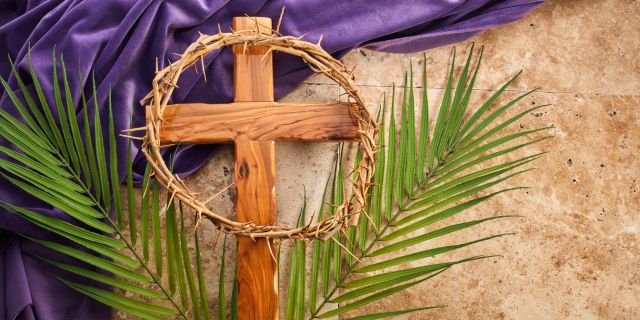The season of Lent is described as a journey, with its final destination being Holy Week. The events of Holy Week recount the so-called ‘passion narratives’ in the New Testament Gospels that relate to the suffering (passio in Latin), death and burial of Jesus Christ.

Palm/Passion Sunday – entrance into Jerusalem
Holy Week begins with Palm Sunday, commemorating Jesus’ ‘triumphal entry’ into Jerusalem where he was greeted with crowds waving palm branches and crying ‘Hosanna!
Ironically, these same voices that greet Jesus as Messiah and King will be the same voices that shout ‘Crucify him!’ just a few short days later on Good Friday.
Traditionally, palm branches or palm crosses are given out on Palm Sunday as a tangible sign of Jesus’ ‘triumphal entry’ into Jerusalem.
Holy Wednesday – into the darkness
‘Holy Wednesday’ is often marked with gradually extinguished candles, creating the sense of growing darkness.
This darkness symbolizes the abandonment of Jesus by his disciples, and anticipates the anguish and tragedy of Good Friday later on in Holy Week.
Maundy Thursday – the Last Supper
Marks the Last Supper that Jesus shares with his disciples, his betrayal by his disciple Judas, and his arrest at the Garden of Gethsemane.
Services will often include an act of foot washing, which commemorates Jesus washing the feet of his disciples on the night of his arrest .
Maundy Thursday reminds participants of the ‘new commandment’ (mandatum in Latin) that Jesus gave his disciples to love one another as he has loved them.
Good Friday – Jesus’ agony on the cross
Commemorates Jesus’ trial before Pontius Pilate, his sentence of death, his torture, and his crucifixion and burial. It is called ‘good’ Friday in the obsolete sense of the word ‘good’ – connoting something ‘holy’ or ‘pious’ (‘Holy Friday’),
Holy Saturday – visiting the tomb of Jesus
Recalls the vigil, the ‘keeping watch’ at the tomb of Jesus. This is the day on which Lent traditionally ends. It marks the final day of Jesus’ death, which he spent resting in his tomb.
